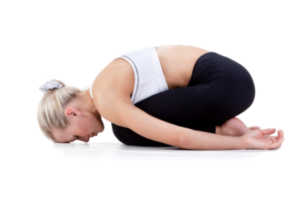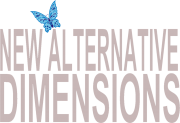 Child’s Pose. From a kneeling position, sit back on your heels and draw your forehead to the floor. Round your back. Bring your arms to rest alongside your torso. Breathe into your sacrum. If your nose feels smashed, draw your forehead slightly toward the chest. Benefits: Engages the parasympathetic nervous system, encourages deep calm.
Child’s Pose. From a kneeling position, sit back on your heels and draw your forehead to the floor. Round your back. Bring your arms to rest alongside your torso. Breathe into your sacrum. If your nose feels smashed, draw your forehead slightly toward the chest. Benefits: Engages the parasympathetic nervous system, encourages deep calm.- Neutral Spine. Try this posture adjustment while seated, standing, or lying down. Gently contract your abdominals toward your spine, lift your rib cage, round your shoulders back and down, tuck your chin slightly, and lift your head toward the ceiling. Lengthen the spine as if backed against a wall and someone was measuring your height. Breathe. Benefits: Improves posture, strengthens the core abdominal and back muscles—key to avoiding backaches and injuries.
- The Great Rejuvenator. Lie on your back with your legs straight up against a wall. Inch your bum up to the wall so that it touches. Remain here for 10 minutes. Roll to your side to come out. (This can also be done resting your bent legs on a chair.) Benefits: Inspires joy, reduces chronic fatigue, recirculates stagnant blood in legs, relieves menstrual cramps.
- Nadi Shodna. Practice alternate nostril breathing with a straight, tall spine and closed eyes. Inhale deeply through both nostrils. Use your right thumb to close your right nostril and slowly exhale out the left. Keeping the right nostril closed, inhale through the left. Switch sides by closing the left nostril with your ring finger and exhaling out the right. Exhale twice as long as you inhale. Go as slowly as you can without creating tension. Continue for 10 breaths. Benefits: Induces sense of calm, balances left and right brain, regulates body temperature.
- Shoulder Shrugs. You can get your energy flowing with this powerful warm-up. Stand with feet hip width apart and your second toes pointing forward. (The second toe aligns with the spine.) Lift your right shoulder toward your ear without moving or tensing the rest of the body. Release and repeat on left side. Continue vigorously for two minutes. Benefits: Boosts circulation in the chest and upper back, opens heart chakra, stimulates creativity and ability to give and receive.
- Merudanda Mudra. Sit with your spine straight and tall. Rest your hands on your thighs. Curl your hands into fists, facing down, with thumbs extending toward each other. Hold consciously for five minutes while breathing slow, even breaths. Benefit: Aggregates strength in the lungs and lower abdomen.
- Bhramari. This pranayama (breathing exercise) is named for an Indian bee. Sit with your spine straight and tall. Close your eyes, placing your thumbs in your ears. Let your two middle fingers gently rest on your eyelids. Inhale deeply. Exhale making a humming sound, keeping your eyes and mouth closed. Repeat three to 11 times. Afterward, keep eyes closed and breathe for a moment. Benefits: Releases anxiety and anger, improves concentration, relieves headaches.
- Eyeball Exercise. Close your eyes and rotate eyeballs in a clockwise direction. Repeat with counter-clockwise direction, 10 times each. Next move your eyes up and down, side to side, and diagonally, 10 times each. When finished, close your eyes and rest for a moment. Benefits: Reduces fatigue, results in crisper, sharper vision after regular practice.
- Foot Opener. Come onto your knees with toes curled beneath you. Reach behind to spread your toes and gently press your heels together. Sit back onto your heels. Knees should be together, anklebones touching, heels directly beneath sit bones. Let the soles of your feet open. Breathe through any discomfort. Sit for two minutes. Benefits: Restores resilience and flexibility to feet, your foundation for all movement.
- Slow March. Lie on your back, knees bent, feet directly under knees. Press lower back half inch toward floor. Place your hands just above the pubic bone. Slowly lift your right leg one inch from the floor and slowly lower. Repeat with left. Continue, 20 times each side. Avoid shifting from side to side. Use your hands to feel isolated muscle movement. Benefits: Activates pelvic floor muscles, establishes connection to your true strength.
